Want an electric conversion? Be prepared to pay big money

About five years ago, I wrote a piece for Hagerty defending vintage car ownership. In it, I said that, on the surface, owning multiple vintage cars may seem as irresponsible as former first lady of Philippines Imelda Marcos owning thousands of pairs of shoes and hundreds of fur coats, but I defended myself and like-minded car nuts by arguing that, from an environmental standpoint, lightly driven vintage cars have a very small carbon footprint. I joked that my 1974 Lotus Europa, having been dead for 40 years, still owes the world a few decades of carbon.
Not long after, I began seeing articles about electric conversions of classic vehicles. There were press releases from both Aston Martin and Jaguar saying—in response to some European cities proposing the closure of their downtown sections to internal combustion vehicles—that they were offering well-heeled clients factory electric conversion of their precious E Types and DBwhatevers. Reading further, this allowed for cost-sharing of the new electric platforms being developed for Jaguar’s I-Pace crossover and Aston Martin’s Rapide E, so the motives were perhaps not as bright green as they seemed.
Aston Martin’s release really caught both my eye and my ridicule, as it referred to its electric conversion as a “cassette,” with the implication that it could be easily slid in and out. “The cassette system offers the perfect solution, offering owners the reassurance of knowing their car is future-proofed and socially responsible, yet still an authentic Aston Martin, with the ability to reinstate its original powertrain if desired.
OK. Well. First, “future-proofed?” Really? Is it going to automatically encase itself in carbonite like Han Solo when sea levels rise or if an asteroid pulverizes the planet?

Second, knowing nothing about electric conversion but a little about engine swaps, the idea that every aspect of a gas-to-electric conversion can be encased in a “cassette” may be good public relations, but it is of dubious engineering merit.
You might infer from this that I’m anti-EV. Not true. I think that electric vehicles, when recharged with power generated by renewable energy sources (e.g. solar and wind) are part of a necessary response to climate change. But I am resolutely anti-hyperbole.
Since then, the electric conversion of classic vehicles, or at least the aggressive marketing of it, appears to have only increased. Nowadays, it seems that you can’t throw a bad condenser without hitting a laptop displaying an article about electrifying classic cars. Shops performing conversion work appear to be springing up in many American cities. Some are single-marque or single-theme, while others are equal opportunity converters.
Normally I wouldn’t pay any of this much mind, but an electric-converted 1974 BMW 2002 recently went up for auction on Bring a Trailer. As I’ve owned 40 of these little German sedans and still own three of them, I couldn’t help having some academic interest. Plus, there’s the odd bit of historical trivia that BMW actually built two electric 2002s that were used during the 1972 Munich Olympics. With 12 Varta lead acid batteries under the hood, the cars had a range of 37 miles at a constant 31 mph. Fortunately, EV technology has advanced over the last 50 years.

The work on the BaT 2002 was performed by a shop in Austin, Texas, that has received favorable press. The company’s website and videos show converted high-dollar classics like an E Type, a long-hood 911, and an Alfa GT Veloce. The company owner and his engineers exude passion for the work and respect for the art form that is a vintage car, and they reason that electric conversion a) makes a car environmentally palatable, b) increases performance, and c) solves the problem of the unreliability of a 50-year-old internal combustion vehicle. If I can nitpick about that last point, in one video, one of the engineers perhaps drank from Aston Martin’s fountain, as he strays from passion to hyperbolae and says that classic cars “are fickle finicky vehicles, but when it’s [sic] run by a massive battery and an electric motor, it’s basically as reliable as a microwave oven.”
I’ve written multiple articles about what I refer to as “The Big Seven” things likely to strand a vintage car. They are ignition, fuel delivery, cooling, charging, belts, clutch hydraulics, and ball joints. I fully agree that if you replace an internal combustion engine and its cooling and charging systems with a modern electric system, you eliminate the first five of these, and that’s nothing to sneeze at. But you still have a classic vehicle with its attendant electrical quirks (funny, right?), old brakes, steering, and suspension, and now you’re adding in the range and “who repairs it?” issues of a one-off electric conversion whose battery capacity is unlike to be that of a ground-up design.
But even assuming there’s a step increase in reliability, there’s a huge overriding issue with these conversions. And it’s not the whole “you’re destroying a classic” argument. As far as I’m concerned, it’s your car—go to town and paint flaming purple Smurfs on the hood if you like. In the case of the BaT vehicle, a BMW 2002 is a common model. There are a lot of them. It’s not like someone is electrifying James Bond’s DB5 (and, even if they were, if you believe Aston Martin, you could always just hit the eject button and swap back in the internal combustion “cassette”).
Nor is it the “you’re destroying the classic’s soul” argument. There’s a whole continuum of paths for ownership of a classic car, from keeping it bone stock, to light modifications for drivability and reliability, to hot-rodded, to wild engine swaps, to turning it into track-only vehicle or a race car. Electrification is somewhere on the right edge of this curve.
Personally, I think if you want a newer, quieter, more-powerful car, you should just buy a newer, quieter, more-powerful car and stop trying to turn your classic into something it isn’t. But to single out electric conversion and point at it—Invasion-Of-The-Bodysnatchers-style—as an affront against man, and God, is silly. That being said, I do have some “soul” concerns. I’ve experienced how even mild modifications such as a stiffer suspension or a five-speed retrofit can change the car in unintended ways, affecting the way it sounds, feels, and vibrates. The relationships we have with our beloved cars are intimate things, and changes in a car’s vibe can affect our connection with it. Even over and above electrification’s obvious “no more gas, oil, and exhaust fumes” and “no more WAAAAAAAAAA-waaaaaaa when you wind it out” issues, I do wonder about the degree to which removing some of a car’s grit and rasp and replacing it with an antiseptic Stepford-wife, golf-cart whine may stress or break the owner-vehicle bond.
But the issue, the thing I’d like to see addressed in the first sentence of every article about electric conversion, is the high cost. The website of the company that converted the BMW 2002 on BaT estimates conversion cost at $50K–$150K, depending on the vehicle’s make and model, the need for general non-electric-conversion restoration work, the desired level of performance, and other factors.
Holy electrons, Batman. You’d have to leak a lot of gas, oil, and antifreeze to approach that.
It made me wonder who spends this kind of money. One of the company’s videos talks about people who “want the ability to appreciate that art form, but they want… a sense that they’re doing it with less impact to our planet” and “want the seamlessness of not worrying, just driving.” That’s great PR, but to me that price tag instantly makes this kind of conversion the province of folks with summer homes in the Hamptons.
My ever-reasonable wife asked me, “How does that compare with the cost of a new EV? Couldn’t a buyer be someone who simply wants a cool vintage electric-converted car to use as a daily driver?” Left-brained me answered that vintage vehicles and daily drivers are usually two different things, and that only a died-in-the-wool car person would likely put up with the wind and road noise, primitive suspension, reliability, and safety issues of a classic car, electrified or not, to try to daily it for anything other than trivially short commutes.
Let’s look at the specifics of the electric-converted 1974 BMW 2002 on BaT. What the car had going for it was that it was converted by a known company, the photos of the converted portions appeared to show excellent work, the car was painted the highly desirable color of Colorado (pale orange), and although it began life as a big-bumpered square tail light 2002, it had received a small-bumper conversion.
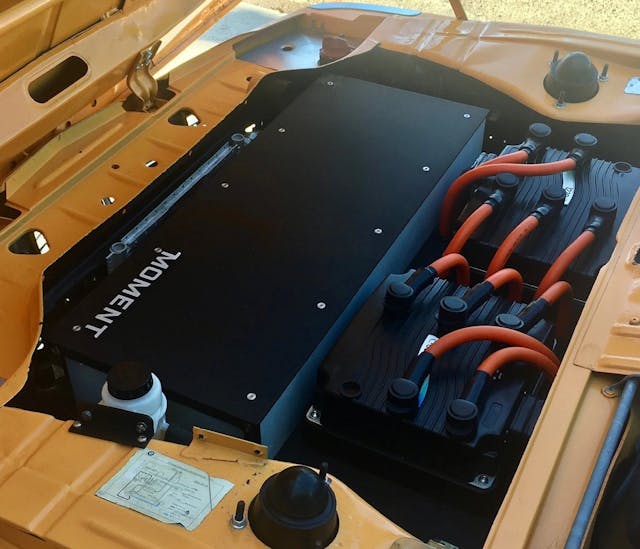
In addition, part of the converter’s design philosophy is to maintain the manual transmission and clutch, as that keeps the car fun to drive, and it doesn’t interfere with the look and feel of the gearshift lever. This car actually had a five-speed in it, which was pretty cool.
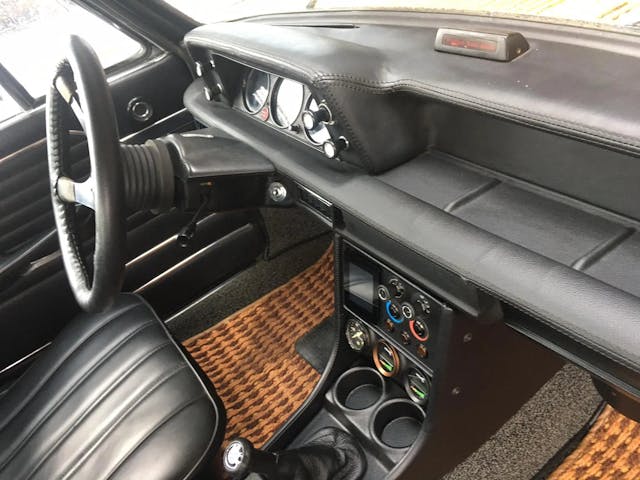
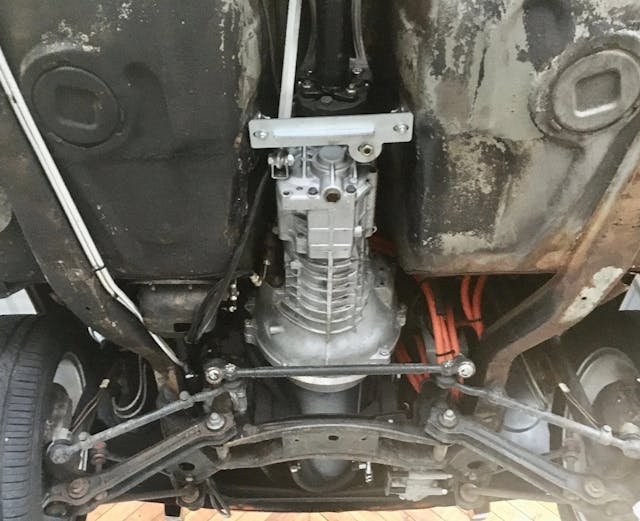
But there were some negatives. The rectangular holes for the original front bumpers’ hydraulic cylinders hadn’t been covered up; the car had been shaved (de-trimmed); it had air conditioning via a modern climate control box, whose vents were occupying the places in the dashboard where the original vent sliders were; and the dash had a stitched leather cover. OK, perhaps only the big bumper holes are a demerit, but while there’s nothing cringe-worthy with any of the other issues, there’s no denying that they collectively moved the car away from a bone-stock configuration. I’d think that from a value standpoint, a blue-chip electric-converted 2002 would be a flawless 1968–73 round-taillight car that looked absolutely stock until the hood was opened. This wasn’t that.
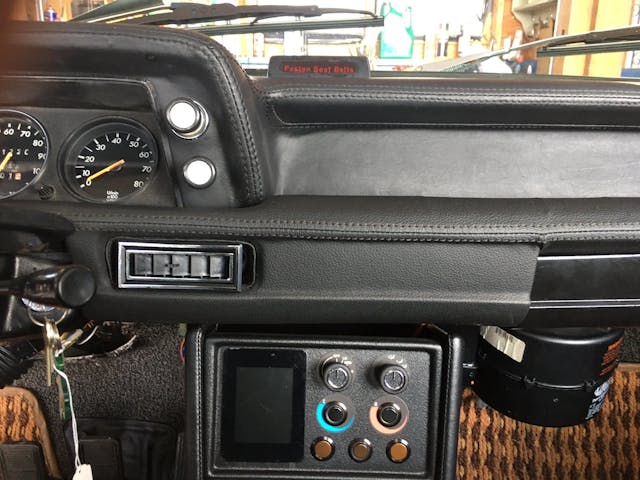

Plus, as pretty as the car’s exterior was, it had not had a rotisserie-style restoration, so the floor pans and subframes showed the small amounts of oxidation that every unrestored car has. Nothing wrong with that; every car I own looks likes this underneath. I imagined that the owner thought of the car as being in the Goldilocks zone for an electric conversion. That is, if it was too rare, too original, or too mint, you might not want to modify it, whereas if it was too beat-up or rusty, it wouldn’t be worth the expense and effort.
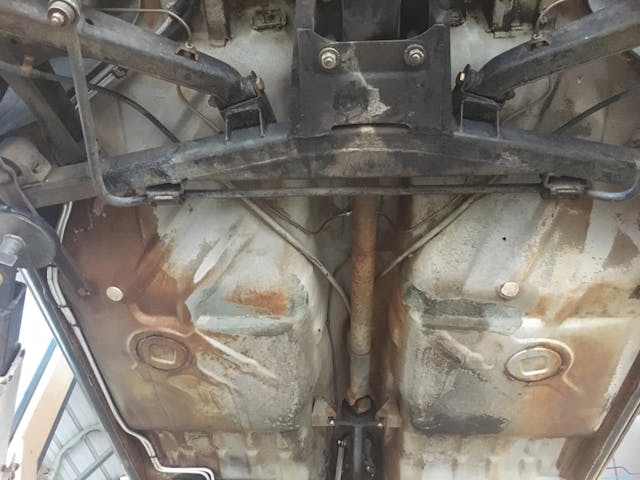
However, as I wrote when I tried to sell my 49,000-mile survivor 2002, what’s valued on BaT and causes bidding wars to head for the stratosphere are cars that present themselves in such a way that potential well-moneyed buyers think they’re bidding on a completed fully-executed whole that needs nothing. The contrast of a car’s freshly painted exterior with an original undercarriage conveys the image that the car is unfinished and holds the price on BaT down for any car. This was no exception.
The kicker was that although the car had a standard J1772 charging connector, and the conversion included a nifty adaptation of the stock gas gauge to display the reserve charge, the seller quoted the car’s range as only about a hundred miles. Gee, maybe things haven’t progressed as far as I would’ve thought since the 1972 Olympics.
Together, all these things added up to caveats that caused the bidding to top out at $42,500. Given the cost estimates listed on the conversion company’s website, I can’t imagine that the sale price wasn’t substantially less than the seller had in it.
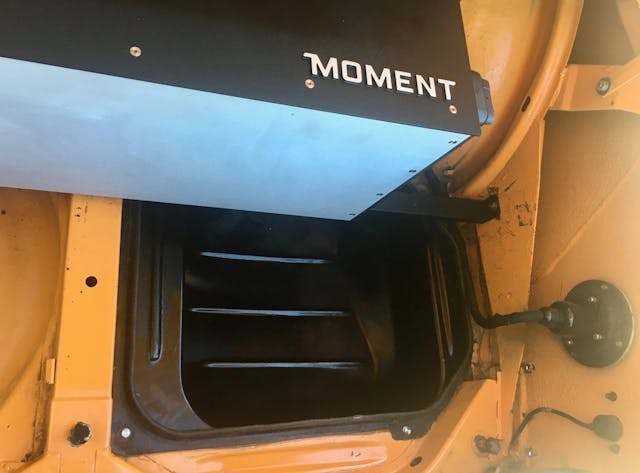
But still, $42,500 is a lot of money, at least it is to me, and that got me thinking.
As I say over and over, I am neither wealthy nor a collector. I own 13 vehicles (including a truck, little RV, and two daily drivers) because they’re either useful to me or they resonate with me in some way, but I struggle daily with both the financial and the storage repercussions. I see many cars locally on Craigslist and Facebook Marketplace that fall into what I think of as a “whim-able” price window. I used to regard this as four grand, in which all sorts of depreciated BMWs and running oddballs like Saab Sonnets, Fiat X1/9s, and ’63 Rambler 770s fall, but I’ve widened my view a bit to eight grand, as that also captures things like running but needy pre-1975 C3 Corvettes.
Still, in an environment of tightly-constrained money and space resources, the thought experiment I perform for any purchase—particularly one that’s outside my wheelhouse—is “What would I actually use the car for?” I know what I use the 1970s BMWs for. I road-trip the hell out of them. Yes, I also pleasure-drive them and use them to run errands—there’s nothing like taking a beloved classic to get milk on a Sunday morning to turn it into an event—but the road-trip part is in both my and the cars’ DNA. The Lotus Europa still hasn’t seen a big road trip, but I adore driving the featherweight little thing on twisty local roads. So, if the answer to the usage question is “I’d probably just drive it to cars and coffee a few times a year,” that’s a fail. I simply don’t have the space or the money to support owning something with that usage profile.
In truth, of course it’s less black and white than that. My 1999 BMW M Coupe (“the clown shoe”) is barely driven these days, and although my 49,000-mile 2002 did recently get a short road trip to Vermont, it’s more of an errand and a local events car. And some of my other ’70s BMWs haven’t seen a multi-day road trip in years.
But still, hypothetically, what would I actually use an electric 2002 (or any electrified classic whose range is only a hundred miles) for? That would seem to effectively rule out spirited day drives with my local 2002 pals. Yes, in theory, 30 minutes of a quick charger attached to the J1772 port should give an 80 percent charge, or another 80 miles, but that doesn’t feel like much. Me, I’d rather have the unconverted car with the range, the fumes, and the chunky rasp when I get on the throttle. And save the $42,500. Or the $50K–$150K, depending on how you want to look at it.
In my first book, there’s a chapter, titled “Restoration and why it makes no freaking sense,” in which I say that buying a car into which someone else has already sunk restoration money is almost always cheaper than spending the money yourself, but note how people pay to have cars restored anyway because it’s all about choice—what pops out at the end is the manifestation of all those choices, and so, naturally, you love it. I think that choosing to have a vintage vehicle electrified is a boutique subset of this larger restoration issue in that people who do it want to do it, probably because a) it fits their environmentally-friendly self-image, and b) they can afford it and the left-brain analytics probably don’t matter that much. I have no argument with that, but if you say that you’re doing it strictly for environmental reasons, and if your daily driver isn’t an EV, I think the justification is pretty thin. And if you say you’re doing it so you can still drive your beloved classic when gasoline is as controlled as ivory, okay, but you’re paying a very hefty premium to be on the bleeding edge. From this standpoint, the buyer of the electric 2002 on BaT made out very well.
So now I can tell you the surprising part: The BaT seller of the electric 2002 and the guy who paid to have the conversion work done was my old friend and BMW 2002 mentor from my days in Austin, Terry Sayther. Terry is 40-year member of the BMW Car Club of America, had a shop in Austin for decades, has forgotten more about 2002s than I’ll ever know, and has done a whole variety of engine swaps. In other words, the last thing he is is my hypothetical hedge-fund closet environmentalist EV-converted classic owner.
When I asked him why he did it, he said he wanted to experience an electric 2002 in the same way he wanted to experience a 2002 with a 240-horsepower S52 engine from an E36 M3 (which he also owns). He said that the electric 02 was very much a pleasure to drive, was a good city car (though more range would’ve been nice), was great to use on date nights with his wife, and, yes, did attract a lot of attention at cars and coffee events. So, you can ignore most everything I said.
Except the price tag.
If I’m still alive when gas really is akin to ivory, and the price of an electric conversion is comparable to that of an engine swap, I’ll likely change my tune (I’m above most things a practical man). Until then, you’ll recognize me because I’m the guy smiling as his car’s leaky fumy internal combustion engine is being wound out.
Really, I just want folks to be careful and realistic. The fact that an expensive boutique-converted electric BMW 2002 has only a hundred-mile range strikes me as a valuable illustration of where EV conversion technology is today and what is and isn’t reasonable to expect when you have to deal with the constraints of a vintage car. The time may come when electric conversion is the necessary and affordable way to keep driving your classic, but that time is certainly not today.
Oh, and that factory Jaguar electric E Type? Be careful what you wish for. This was the 2018 press photo of the dashboard in the prototype. If I ever owned an E Type, plunked down mortgage levels of money for electric conversion, and the interior came back looking like this, I’d want 10 minutes in a windowless room with the people who cashed my check.

***
Rob Siegel’s latest book, The Best of the Hack MechanicTM: 35 years of hacks, kluges, and assorted automotive mayhem, is available on Amazon. His other seven books are available here, or you can order personally inscribed copies through his website, www.robsiegel.com.


A fool and his money………
‘So, if the answer to the usage question is “I’d probably just drive it to cars and coffee a few times a year,” that’s a fail.’
People never point out that a with a lightly driven EV conversion, one is paying and repaying for the energy to make it go. That fresh charge will slowly discharge while the garage queen sits, waiting. To be filled again.
Unlike an ICE collector car that has a tankful of gas and a bottle of some sort of fuel stabilizer which can be ready to go at a moment’s notice. It’s not eating up energy between uses. Tank paid for.
Unlike the constant cost of “filling up” a battery that starts to discharge the minute it’s topped up whether you drive the thing or not. ICE is not eating gas while it’s parked. An EV is always depleting whether driven or not.
Plus the inevitable cost of replacing the battery pack. Unless one wants just a garage decoration or static display….You can bring a battery operated radio to sit in it and stare at the wall…
These conversions are rich people’s toys.
Interesting article & comments section!
(1) How about trying to market carousel horses with e-bikes under them to wealthy equestrians as “EV conversions?” (E-Bikes actually make much more sense when you think about range and what a ICE motorcycle or moped would be used for.)
(2) I learned from an exhibit in a Maine transportation museum that the ICE automobile’s replacement of the former widespread use of horses as “in town” transportation helped solve the severe problem of horse dung creating unsanitary conditions and spreading diseases in the cities.
(3) Is there now wide-spread acceptance of the argument that cows are bad for the planet because they fart?
– Lots of serious things to ponder about how to save our planet.
Now I need to check my oil, because I know the battery is charged for the next six months.
Electric??? Not in my lifetime. I’d rather be like Mad Max. Electric cars are garbage, always have been, always will be. Hydrogen will take over long before most have wasted their cash on electric garbage.
I own a 2002 Saturn SC2 automatic with the driver-side dog door showing 215,000+ miles. The body is #3 with minor paint issues on the rear deck and bumper while the interior has a partially detached headliner, but great upholstery and door cards with no rips.
Without doing any research, I think it would be a fine electric conversion candidate. The battery pack could replace the back seat with easy side access while the motor would go up front, leaving the trunk as is. It would be like an EV1 tribute and appropriately since GM assigned service and distribution of that ill-fated experiment to the equally ill-fated Saturn Division.
I use this car solely for my commute which is 70 miles round-trip so a 100 mile range would work fine for me. To cut conversion costs I would skip regenerative brakes and retain the non-ABS front discs/rear drums.
But the stars fall from my eyes when I consider that where I live a 10-year old Nissan Leaf with less than 50,000 miles can be had for well under $10,000. Even replacing the batteries in a few years would, I suspect, still keep the overall price below even a basic, no-frills conversion.
So, yeah, obviously a 20-year old electric Saturn dog door coupe would be infinitely cooler than a 10-year old Leaf, but it just doesn’t pencil out. And if it doesn’t make sense for a non-collectable car in great condition but worth very little as is, I’m almost positive that converting a classic or even near-classic car would more than likely be regretted further on down the road.
In many ways an EV-converted classic car seems to make sense because one would assume that a good number of classic car owners only use their cars occasionally as weekend toys so these vehicles are not on the road very much. This means that the battery will likely hold out for many years. So many owners will likely keep the cars without worrying about replacing the all-expensive battery pack. And I also assume that a good number of classic car owners (yes, I know there are exceptions) drive their vehicles for only short distances, so driving range is not really an issue either. Here come the “buts”…many classic car owners are people of average means who may not have the exorbitant amounts of money required for a well-done professional conversion. Regarding performance, weight and balance is extremely important for the handling of some collectibles and classics. As an example, I drive an NA Miata, where balance is all-important for the vehicle’s handling. I can only imagine how a heavy battery pack would effect my car’s handling. It would no longer be a Miata but some kind of a Frankenstein EV creation. That’s not something I like. But the worst part of an EV conversion is that the car would lose its character and charm. An EV conversion is tantamount to performing a lobotomy on your best friend. All you would have is a shell–something that looks like your classic but really isn’t. Classics have a special aura, a kind of charm and character that non-enthusiasts just don’t get. We attach something to these vehicles that’s almost spiritual in nature. Your classic is a way of turning back the clock and time traveling, if only for a few hours on a long windy road. Part of the historical charm is the internal combustion engine and all the stuff that goes along with it–leaking oil, exhaust and that beautiful sound of combustion chambers exploding. An EV conversion will change the character of the vehicle to the point where it loses its identity. It becomes just another anonymous, ubiquitous mode of transportation like everything else on the road today. Most people think that technological advancement and progress go hand-in-hand. That’s not always the case. Sometimes more technological advancement actually makes things worse, not better. Sometimes more technology is a step back, not a leap forward. I know this sounds odd to most modern people and may not make too much sense but strangely enough it’s often true. And I think EV conversion of classic cars is a case in point.
You guys are looking at this from the perspective of classic car enthusiasts.
Look at it from the perspective of an EV enthusiast. What EV gives you the style, quirks, and enjoyment of a classic? A Hyundai? Nissan? Anything from Tesla? Nope, nope, and wow, NO!
A classic conversion is the best way to build an EV with classic character!
Note: Lots of classics can’t go 200 miles on a tank of gas. Triumph Spitfire. Turbocharged Corvair. Heck, even my Kia Sportage couldn’t muster 200 miles. The obsession with 300+ mi range is partially fueled by amnesia.
And don’t forget: A large portion of grid energy (in most of the US) is renewable (hydro). EV brakes take forever to wear out, because much braking is done regeneratively. And you actually CAN do a cheap EV conversion… if you’re willing to put up with some typical classic quirks.
All EV talk should be put on the back burner until our infrastructure can support a dedicated 50amp charger in every driveway, or even every other driveway
This isn’t necessary. 20 A at 240 V is more than enough and easily supportable by nearly every neighborhood in the US.
Biggest gripe about conversion, I am someone that actually did one back in the late 1990’s so I might know something, is that there are so many fuel tank shapes out there it makes battery boxes almost bespoke parts on anything but a pickup.
Honestly I expect the best cars to convert are going to be the top selling econo boxes. They will be cheap, plentiful, and converting them won’t be seen as a crime against humanity. If a company can make a pack for just a few cars they will be able to make them at a reasonable price, the rest of the kit is a fixed price item after that.
Gasoline isn’t going away anytime soon–Probably never completely- (as long as it’s profitable) -& it’s logical that they will come up with a cleaner gas– Like lead additives for classic cars–it will become more expensive–Classic cars are expensive & we make choices–The money I spend on mine really should be put on my Morgage-esp on my income-Not my Toy- But just like the kids spending lots of money on computer games–it’s my entertainment- I laugh when I read that these folks with a half dozen or more “”Drivable”” classic cars say they arn’t rich -they are at least very well off -It seems that the better off people are the more they complain- I think it’s a small %age of people who don’t modify their Classics for lots of folks it makes more sense to convert to electric–esp as we get older because of the effort to maintain an old car–
“OK. Well. First, “future-proofed?” Really? Is it going to automatically encase itself in carbonite like Han Solo when sea levels rise or if an asteroid pulverizes the planet?”
later
“But I am resolutely anti-hyperbole.”
So, spend 100K and get a 100 mile range. “Duh, ok…” in my best Homer Simpson voice. The reply above about a 12mpg Camaro? Its either a firebreathing monster or you got some tuning issues. I was getting better than that from a .060 over 454 with 3.73 gears and 2200 stall converter. I calculated 1 night that I’d gotten 14mpg after a long night of street racing and stop n go cruising. Efficiency. I’m currently finishing a 39 Ford Std which I plan to cover a lot of miles with, using a 239 flatty. What our community needs to do is use our voice collectively to point out the farce of 1hr charging, limited range, battery cost, INCREASED DAMAGE TO THE ENVIRONMENT, and the grid already at its limits without a community of essentially mig welders running all night charging unicorns. Part of our “thing” is our knowledge of mechanical and industrial processes used to create the cars we love. What’s the carbon footprint of a single windmill? All that fiberglass? The gel coat and resins? I got 2 words for ya, “petroleum distillates” to make it. Show of hands, who knows that a windmill has to have up to 60gal of oil changed every 4000hrs? Anyone? Do they tell us that? Hom much carbon to swap blades (which only last for 10 years)? And why the push AGAINST hybrid? Sorry Hagerty car community, WE need to do better to set aside the niche market toy of the electric car as a replacement or standard of transportation. Another overlooked tech approach? CNG. Safe, clean, easy to use, resource transport already in place, abundance. No? Why? Wrong industry thrives? It’s madness and I’m happy to see this story and the final result. And forced conversion of my 39 sedan? Molon Labe…
My idea of an electric conversion is to drop an LS into a Tesla
Now THAT would be a hit a Cars & Coffee!
I have to keep telling people this: EVs are not the future at all. They are nothing but another disposable appliance that will be useless in 5-10 years. Except there is no way to recycle the batteries. If fossil fuels have to go away (which they shouldn’t), liquid hydrogen will be the answer. Making cars the way we make them now will work with liquid hydrogen with different fuel cells and computer calibrations. The car fills up the same way in the same amount of time. That is the most viable option. I’m sick of hearing about the climate change nonsense and that its all the cars and cows farting causing it. The 100 largest companies in the world account for 71% of all greenhouse gas emissions. Why aren’t they being demanded to clean up instead of letting them buy carbon offset credits? I’m sick of all this political pandering so people can line their pockets more with their “investments”.